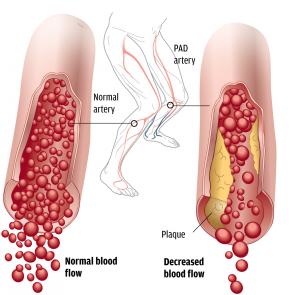Peripheral Arterial Disease (PAD) is a common circulation problem. PAD, or peripheral arterial disease, is the narrowing of blood vessels outside of the heart and brain. It’s often caused by the accumulation of fatty deposits in the arteries (atherosclerosis). When these arteries become clogged, blood flow to the arms, legs, and certain organs is restricted. This can result in limited mobility, increased risk of heart attack or stroke, limb amputations, and, in some cases, death. An estimated 27 million people in Europe and North America have PAD; 60% of those individuals have no symptoms. Individuals with PAD are at an increased risk of heart attack and stroke. A simple test, the Ankle-brachial index, is used to diagnose PAD by comparing the blood pressure in the ankle and arm to see how well blood is flowing.

Symptoms
- Painful cramping in your hip, thigh, or calf muscles after activity, such as walking or climbing stairs (intermittent claudication)
- Leg numbness or weakness
- Coldness in your lower leg or foot, especially when compared with the other leg
- Sores on your toes, feet, or legs that won’t heal
- A change in the color of your legs
- Hair loss or slower hair growth on your feet and legs
- Slower growth of your toenails
- Shiny skin on your legs
- No pulse or weak pulse in your legs or feet.
- Erectile dysfunction in men
Risk Factors
- Smoking
- Diabetes
- Obesity (a body mass index over 30)
- High blood pressure (140/90 millimeters of mercury or higher)
- High cholesterol (total blood cholesterol over 240 milligrams per deciliter, or 6.2 millimoles per liter)
- Increasing age, especially after reaching 50 years of age
- A family history of peripheral artery disease, heart disease, or stroke
- Excess levels of homocysteineFor more information, read on at the American Heart Association.
